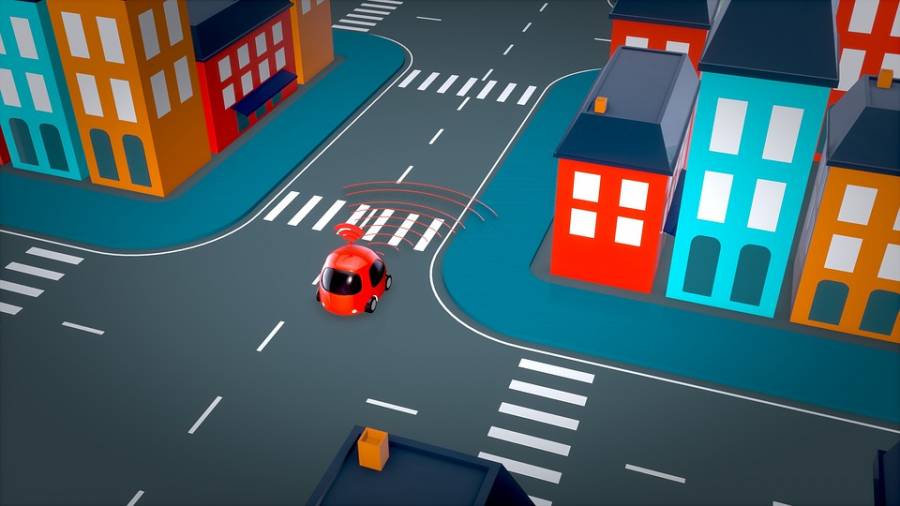The first time self-driving cars were introduced to the world, it was through science fiction films and television of yesteryear. For self-driving systems, infrastructure and industry efficiency are everything.
Today, however, they’re a reality, and they’ve taken the Fourth Industrial Revolution to wild destinations. Consider the man who recently traveled 30 miles on a California highway using just the autopilot feature of his Tesla — all while he was asleep.
Thanks to autonomous technologies, it won’t be long until computers entirely control much of the world’s driving experience.
But to become a fully viable, ubiquitous option, there are still significant hurdles to clear. At this pivotal moment, it’s worthwhile to explore where self-driving is headed as well as what’s helping and hindering that progress.
Surveying the State of Self-Driving Technology
To start with, it’s helpful to review the kinds of technology that allow cars to drive autonomously in both their present and future forms:
• Artificial intelligence:
Artificial Intelligence is affecting cities also. Sophisticated AI enables self-driving vehicles to make all the calculations necessary — every second — to understand everything occurring on the road. Consider, for instance, a self-driving car approaching an intersection.
The car sees a pedestrian is standing at the corner. The vehicle must determine whether to slow down because the person is likely to cross the street or maintain speed because the pedestrian is not a threat.
Making these calculations quickly is hard enough for the human brain — let alone a machine’s. However, AI has progressed to a place where it can make accurate judgments almost instantaneously.
• Machine learning:
The other crucial component of autonomous driving is machine learning. As intelligent as AI may be, it’s unfeasible from a technological standpoint for AI to analyze every scenario. Instead, it must be able to learn from the road and begin driving based on experience — just like a human would.
Therefore, the first time a car sees a pedestrian at an intersection, it may run a complex series of calculations. However, when it reencounters the same scenario, it can retrieve the data it previously collected rather than attempting to collect it again. Bottom line: AI can drive a car, but machine learning helps it become a good driver.
• Sensor communication:
And while that’s the tech going on inside the car, self-driving cars are not self-contained. Eventually, they will rely on a vast series of sensors and signals located on other vehicles, traffic lights, and every feature of the traffic infrastructure.
These sensors allow cars to “communicate” with one another (and with the traffic infrastructure as a whole) to make driving as safe and efficient as possible.
In this regard, BMW has been on the vanguard, developing a system that allows many of its newest models to share data. For example, imagine two new BMWs traveling down a highway together: When the first encounters an accident or construction zone, it can transmit that information to the car behind it.
These actions are helping the vehicle and driver avoid unexpected hazards. Before long, this technology will no longer be proprietary to any single automaker but will instead be a standard feature.
Self-driving technologies can do incredible things.
The self-driving cars do incredible things, but only when they’re enabled by wireless connectivity. The connectivity means blazing-fast bandwidth, and incredible processing capabilities. Currently, most self-driving cars rely on fourth-generation tech and the cloud to handle data.
Edge computing will eventually replace this technology to keep data processing more localized and to make data transfer instantaneous via better 5G connectivity. At that point, self-driving vehicles will be smart enough to literally “take the wheel,” removing drivers from the equation.
Forecasting the Future of Autonomous Vehicles
Most experts agree: Self-driving will experience two distinct phases, both technologically and economically. The first phase involves self-driving auto companies that will likely rise and fall quickly; they cannot successfully commercialize innovations or build viable business models around them. Realistically, we’re in the middle of this phase right now, meaning many of the companies making breakthroughs in self-driving are unlikely to be significant players in the future.
The more critical evolution is on the technological front. Currently, self-driving cars are not autonomous; they provide various types of assistance to human drivers. The next phase will come when vehicles can drive themselves without requiring any input from a driver.
Somewhat paradoxically, self-driving cars become a lot simpler and safer when you eliminate humans from the equation.
Humans are unpredictable by nature and, frankly, don’t often have the best driving track records. So imagine the complexity of self-driving systems trying to make sense of their surroundings. Because of so many variables in play, self-driving must always err on the side of caution (making it less efficient as a result).
To fully realize the dream of self-driving technology, we need computers in every car on the road — and those roads to be located primarily in smart cities.
At that point, driving becomes a predictable system in which all elements are integrated and working in concert. Cars become points on a grid — points that technology can monitor and manage with precision.
An example of this principle is already underway in Utah: Local officials have approved testing of a self-driving shuttle that could supplement (and maybe even replace) other public transportation options. These shuttles will share the road with human drivers, but they’ll travel along set routes and schedules, eliminating the number of unknowns.
Because predictability is still necessary, we’re likely to see self-driving trucks that travel only between set points before we see “robotaxis” that drive wherever the passenger wants.
While the timeline of the self-driving innovation evolution is admittedly tough to pin down, Daimler Trucks boasts an autonomous technology division tasked with bringing “highly autonomous” commercial vehicles to the roads within the next decade. Meeting that milestone is not unrealistic, but it won’t be effortless, either. No company will be able to do it on its own.
Tracking the Momentum in the Industry
Despite the apparent momentum around self-driving technologies, several factors limit how quickly it’s being developed and implemented.
The first? Autonomous vehicles are mainly being developed by Silicon Valley rather than by traditional automakers. Tech companies can push the limits of AI and machine learning, but they can’t necessarily build and sell vehicles on a massive scale.
Self-driving vehicles also don’t possess the same influence on transportation policy that legacy automakers have cultivated over time.
Therefore, some of the most promising self-driving tech exists only in prototype form, with no real path or future of becoming production models.
The second hurdle involves the push for self-driving technology: Traditionally, the argument for autonomous vehicles involves drivers being able to relax on their commute.
Enticing though it may be, the best application of self-driving technology is for commercial rather than personal use. Consider the number of companies (and entire industries) dependent on fleets of vehicles and armies of drivers.
Anything that must be driven by a human — from a forklift to an 18-wheeler is more expensive to operate because of labor costs, scheduling issues, insurance concerns, and accidents.
In that context, the best argument for self-driving technology applies to various industry applications and logistical challenges, not the daily commute.
Once the broader economy understands this, expect additional investments and a wave of new self-driving applications. The final (and arguably biggest) hurdle is the need for 5G bandwidth and edge computing capabilities in tomorrow’s smart cities.
Much has been made of updating the wireless network for the needs of a connected future, but progress has been slow. Without extensive connectivity inside and outside major cities, self-driving cars will never be “smart” enough to be safe.
For instance, a delay of just two seconds could be the difference between an unfortunate accident and a close call. Until we upgrade connectivity and local processing power, self-driving cars will be riskier than most consumers, and commercial operators can accept.
Currently, this information is not discussed enough. The discussions are hypothetical, but deserve to be underlined: Self-driving cars depend on the smart cities around them.
Thankfully, cities are getting smarter than we know.
A Self-Driving City in Action
Ask someone what city leads the way in terms of self-driving, and he’s likely to guess San Francisco or New York. To the contrary, a Rust Belt metropolis is expected to become the first city with autonomous vehicles in widespread use.
Pittsburgh has quietly become a hub for AI development, primarily driven by the efforts of Carnegie Mellon University. The college is among the world’s finest in AI research, and Pittsburgh is home to a bigger pool of AI talent than almost anywhere outside of Silicon Valley.
In fact, because of the pioneering work done at CMU, the school was selected to partner with the United States Army on AI development. Google and Uber have also chosen to set up AI and self-driving research centers in Pittsburgh, which only funnels more talent and more significant investment into the city.
The city is also home to several legacy industries (steel is one, of course) that have a lot to gain by embracing automation as broadly as possible. As those companies begin to recognize the commercial application of autonomous vehicles, they’ll likely boost research and development investments.
As important as talent and investment are, neither matter without municipal leaders to back them.
Ultimately, lawmakers control the roads, and whether self-driving achieves its full potential depends mostly on their willingness to embrace it.
Once again, Pittsburgh leads the nation on this front: Legislators have declared their intention to make the city an innovation center, and they’ve started laying the legal groundwork to make it happen.
Some developments include working out details behind installing sensors to track traffic patterns, implementing enough bandwidth to enable citywide data sharing, and eliminating red tape that could inhibit self-driving implementations.
I even invested in a Pittsburgh-based self-driving company called Locomotion after recognizing its contributions to the community’s “smart city” dreams.
There’s still much work to be done at the state and local levels before Pittsburg runs on autopilot, but all the pieces are in place.
Pittsburgh as an example is essential here: The city illustrates all that’s promising about self-driving technologies, along with all the remaining obstacles. The city’s approach — one that involves a coalition of academia as well as private and public sectors — is one that all others should model.
We can’t count on Silicon Valley alone to pioneer self-driving, and legacy automakers can’t do it, either. Instead, we must be realistic about what self-driving requires while also recognizing that the most valuable application of autonomous vehicles is in commercial settings.
Once that happens, expect to see this technology transform all our expectations of transportation.










